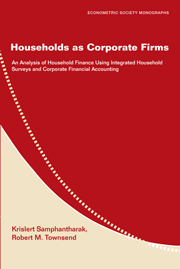 Households as Corporate Firms
Households as Corporate Firms Book contents
3 - Household Surveys
Published online by Cambridge University Press: 05 January 2013
Summary
Part II of the monograph demonstrates how researchers can construct household financial accounts from household surveys. In this chapter, we argue that the data needed for the construction of household financial accounts must have certain characteristics. They have to be panel data that are preferably collected at a high frequency, e.g. every month. The data must be comprehensive. They must cover a wide range of activities performed by the households and at the same time must be detailed enough to allow researchers to identify individual transactions of the households. This type of data can be obtained from an integrated, panel survey of households.
We start this chapter with an overview of household surveys and their relation to an analysis of household finance in section 3.1. Since the construction of financial accounts utilizes a high frequency survey with detailed questionnaires, we discuss in section 3.2 the trade-offs involved in such surveys. Finally, section 3.3 provides the readers with background on the Townsend Thai Monthly Survey since we use that survey as our illustrative example in this monograph.
HOUSEHOLD SURVEYS AND HOUSEHOLD FINANCE
Household surveys are essential for researchers to understand household behavior and for governments to design and evaluate policies. In principle, researchers should design a survey to reflect the objectives of their study. There are generally two broad types of household surveys. The first is a survey that is specific and limited to certain issues.
- Type
- Chapter
- Information
- Households as Corporate FirmsAn Analysis of Household Finance Using Integrated Household Surveys and Corporate Financial Accounting, pp. 31 - 46Publisher: Cambridge University PressPrint publication year: 2009


